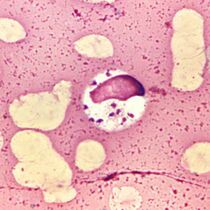Perkinsus marinus
Classification
Eukaryota; Sar; Alveolata; Perkinsozoa; Perkinsea; Perkinsida; Perkinsidae; Perkinsus
Species
Perkinsus marinus
Description and Significance
Perkinsus marinus is a protist belonging to the Eukarya Domain. P. marinus is about 2 to 4 μm long and contains two flagella that aid in their movement throughout their marine habitats. These protists are primarily located along the North American East coast from Maine to Florida, as well as along the Gulf coast to the Yucatan Pennisula. Known as just Perkinsus, or Dermo, this parasite is responsible for increasing mortality rates of many Eastern oysters.
This is an important issue to recognize because these parasites affect many oyster farming operations. Oyster farming is an aquaculture practice that consists of breeding and raising oyster species for pearls, mainly, and for their inner organs, to be eaten, and their shells. Considering that the French oyster industry have be heavily relied on oyster farming since the late 18th century, these oyster mortality rates can affect overall food and market production.
Genome Structure
Not much is known about this microbe, but we do know a little. P. marinus contains two genomes within its nucleus, 86 Mb encoding proteins, and mitochondrion, using mRNA. Its DNA is linear considering it belongs to the domain of Eukarya. Not much is known about their sequence. Research has found information on its serine protease (SP) genes. It revealed a polypeptide chain of 416 amino acids with an approximate molecular weight of 47840 Da.
Cell Structure, Metabolism and Life Cycle
Perkinsus marinus is a Eukaryote, meaning that it is an organism with membrane bound organelles. The most noticeable characteristic of all species of Perkinsus is the ultrastructure of the zoospore. P. marinus contains an anterior and posterior flagellum. P. marinus has normal metabolism rate.
P. marinus is ingested by the oyster host, often an oyster from the genus Crassostrea. The microbe then becomes a trophozoite which proliferates into the host tissues. P. marinus will often infests the hemocytes, cells that are found in the blood of the hosts, as well as the intestine, connective tissues, gills, and digestive glands. Once inside the cell, the trophozoites produces a vacuole that displaces the cell nucleus. The trophozoites will then undergo binary fission to produce immature trophozoites. These will then stay in the host animal where it can either infest in its tissues, be released into the water in feces or from a dead host to then spread to other oyster victims.
Pathogenesis
Found mainly on the East coast of the US, Perkinsus marinus causes the disease known as dermo or perkinsosis. These diseases are characterized by the degradation and mortality in oyster populations. Transmission of this parasite is direct from oyster to oyster. Once the protist is inside its host, it releases trophozoites into host tissue and or their bloodstream. There, they infect more cells or are excreted or released when the host dies. Victims of this disease become stressed, their tissues turn pail, reproductive rates decline, and its growth rate slows, become emaciated, their mantles shrivel and pulls away from the shell, which can cause pockets of pus-like fluid. Blockage of blood vessels and lysis of tissues causes fatality. But surprisingly, oysters can live up to 3 years which active infections. One of the main environmental clues associated with oyster mortality is high water temperatures.
References
https://www.cell.com/trends/parasitology/fulltext/S1471-4922(20)30130-6 https://en.wikipedia.org/wiki/Perkinsus_marinus https://www.dfo-mpo.gc.ca/science/aah-saa/diseases-maladies/pmdoy-eng.html https://scholarworks.wm.edu/cgi/viewcontent.cgi?article=1505&context=vimsarticles https://en.wikipedia.org/wiki/Oyster_farming https://www.kerafast.com/item/841/perkinsus-marinus-cb5d4-pmmoe-gfp https://www.int-res.com/articles/dao2004/57/d057p117.pdf
Author
Page authored by Kieran Duncan, student of Prof. Bradley Tolar at UNC Wilmington.

